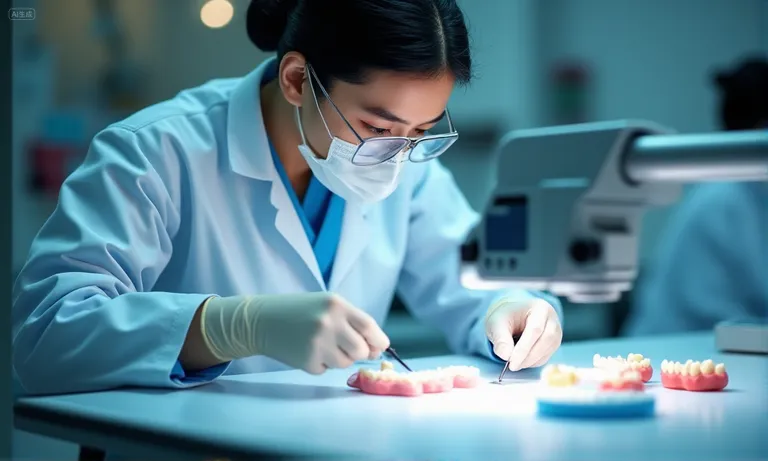Evaluating quality assurance (QA) and remake rates is one of the clearest ways to judge whether a dental implant lab can support sustainable long-term collaboration. A lab with transparent remake data, proven compliance (ISO, FDA, CE), and structured QA systems provides procurement teams confidence not only in today’s case outcomes but also in the stability of future supply chains.
Procurement managers often face recurring challenges:
- Uncertainty about what remake rates actually reveal regarding reliability and consistency.
- Limited visibility into QA systems, including inspections, certifications, and material traceability.
- Difficulty comparing remake data across suppliers to establish meaningful benchmarks.
- Lack of clarity on ROI implications, including turnaround times, cost predictability, and clinical trust.
- Gaps in procurement conversations, such as which questions to ask on remake policies, logistics, and outsourcing risks.
By treating QA and remake rates as structured evaluation criteria, procurement leaders can identify labs that combine low remake rates, robust QA protocols, and operational transparency. The result is fewer remakes, reduced hidden costs, and a stronger foundation for predictable quality, resilient partnerships, and long-term supply chain stability.
Why Remake Rate Is the Strongest Signal of Lab Reliability
The remake rate of a dental implant lab provides one of the clearest windows into its reliability. While many labs may claim high-quality standards, the percentage of cases that require rework reveals whether their processes consistently deliver on expectations. Procurement teams evaluating potential partners should treat remake data as a measurable KPI for long-term stability.

dental-lab-remake-rate-quality-control
Industry benchmarks for acceptable remake rates
Most international benchmarks suggest that remake rates under 3–5% are acceptable for dental implant restorations. Rates above this threshold signal issues in material selection, technician consistency, or workflow accuracy. When labs can demonstrate remake percentages consistently below the industry average, it indicates that their QA systems are well established.
How remake rates impact costs and supply chain stability
High remake frequency directly translates into hidden costs—not only for additional lab work but also for shipping delays, lost chair time, and dissatisfied patients. A clinic or DSO relying on a lab with unstable remake performance may face bottlenecks in delivery schedules and increased overheads. Conversely, a lab with a proven track record of low remake rates helps ensure predictable turnaround times and cost control.
Why remake rate data is critical in supplier evaluation
Unlike marketing claims, remake data is quantifiable and comparable across suppliers. Requesting monthly or quarterly remake reports, ideally broken down by restoration type, gives procurement teams a transparent view of actual performance. Labs willing to disclose these figures demonstrate confidence in their processes and accountability toward long-term partners.
For clinics seeking a dependable overseas dental lab, remake rates function as a trust metric—an early indicator that prevents costly trial-and-error. Evaluating this data alongside quality assurance practices builds confidence that the chosen partner will deliver consistently over years of collaboration.
What Are the Core Elements of a Dental Lab’s Quality Assurance System?
A strong quality assurance (QA) system is the foundation of a reliable dental implant lab. It ensures that every case—from single crowns to complex full-arch restorations—follows structured controls that minimize errors, reduce remake rates, and maintain compliance with global standards. Buyers evaluating suppliers should always look for these core components.

dental-lab-quality-assurance-procedures
Standard operating procedures and inspection checkpoints
A reliable lab follows documented SOPs at every production stage, from digital file intake to final polish. Key checkpoints include:
- File verification before design begins.
- Material confirmation before milling or pressing.
- Fit and margin checks during try-in stages.
- Final aesthetic and structural inspection before dispatch.
Certifications and compliance with ISO, FDA, CE
Certifications provide external validation of a lab’s QA. Procurement teams should verify:
| Certification | What It Ensures | Why It Matters |
|---|---|---|
| ISO 13485 | Medical device quality system | Standardized procedures & traceability |
| FDA registration | Compliance for U.S. market | Legal access and safety assurance |
| CE marking | EU conformity | Confidence for EU distribution |
Labs with valid, updated certifications demonstrate a commitment to international standards, not just local practices.
Material traceability, batch tracking, and documentation
Every lot of zirconia, alloy, or resin should be traceable back to the supplier batch. Proper QA systems keep logs of:
- Supplier certificates of analysis.
- Batch numbers linked to each case.
- Digital records for long-term compliance.
This protects clinics against recalls, ensures biocompatibility, and provides documentation for audits.
Internal audits and process reviews
The most reliable labs run periodic internal audits, reviewing remake trends, technician performance, and compliance gaps. By using this feedback loop, they improve consistency while preventing recurring issues. For overseas dental labs, sharing audit summaries with clients builds additional trust and transparency.
A robust QA system is not just about catching mistakes—it is about preventing them. For procurement teams, verifying these elements helps distinguish between labs that talk about quality and those that consistently deliver it.
How to Evaluate QA and Remake Data Across Different Suppliers?
Comparing remake data and QA practices across multiple dental labs is one of the most effective ways to separate reliable partners from average vendors. Procurement teams should not rely solely on claims but instead request and analyze documented evidence before making a long-term decision.

dental-lab-qa-remake-data-comparison
Requesting remake rate reports and QA documentation
The first step is to formally request detailed remake statistics. A structured process should include:
- Asking for monthly or quarterly reports that show total cases and number of remakes.
- Requesting breakdown by restoration type (e.g., crown, bridge, full arch).
- Reviewing QA documentation, such as material traceability logs or internal audit summaries.
Labs that respond quickly with clear data demonstrate operational maturity and transparency.
Comparing data across multiple labs against benchmarks
| Lab | Reported Remake Rate | Industry Benchmark | Transparency Level |
|---|---|---|---|
| Lab A | 2.8% | 3–5% | Full documentation provided |
| Lab B | 6.1% | 3–5% | Partial disclosure |
| Lab C | 3.5% | 3–5% | Regular updates, detailed by case type |
By placing labs side by side, procurement teams can immediately spot outliers and prioritize partners that fall below or within benchmark ranges.
Using trial cases to validate real-world performance
Paper reports alone may not tell the whole story. Running trial cases with multiple suppliers helps verify:
- Actual remake frequency during real workflows.
- Responsiveness to corrections and adjustments.
- Turnaround consistency under time-sensitive demands.
Trial validation gives procurement managers a real-world baseline that complements formal documentation.
Evaluating remake and QA data across labs avoids the pitfall of relying on one-sided marketing claims. Instead, it enables a structured, evidence-driven selection process where performance can be quantified and verified before scaling up cooperation.
How Do QA and Remake Rates Affect Long-Term Partnerships?
The quality of a dental implant lab is not only reflected in individual cases but also in its long-term performance. Low remake rates and robust QA systems translate into stability, predictable costs, and trust—factors that shape whether a partnership grows or breaks down over time.

ALT: dental-lab-long-term-partnership-trust
Consistency of outcomes and reduced rework costs
Every remake consumes time, resources, and clinical chairside adjustments. Over years of cooperation, even a small difference in remake rate—say 3% versus 6%—can add up to thousands of extra hours and significant cost increases. Consistent outcomes strengthen the buyer’s confidence that the lab can handle volume growth without hidden inefficiencies.
Predictability in turnaround time and planning
When remake rates are low, delivery timelines remain steady. Procurement managers benefit from:
- Reliable scheduling for surgeries and patient appointments.
- Fewer emergency adjustments, which disrupt clinical workflows.
- Stronger planning confidence, especially for DSOs with multi-site operations.
Predictability in logistics is often the hidden advantage of strong QA systems.
ROI and trust in ongoing collaboration
A partnership’s value is measured not just by initial unit cost, but by the total cost of ownership. Lower remake rates reduce rework costs and chairside time, delivering better ROI for clinics and procurement teams. Over time, transparency in QA reporting and consistently low remakes build trust, creating a partnership that evolves from transactional purchasing into a strategic collaboration.
For overseas dental labs like Raytops, proving long-term reliability means showing that QA is embedded into daily operations. This commitment helps clients feel secure scaling their case volume, knowing that costs and outcomes will remain under control.
What Procurement Questions Ensure Transparency in QA and Remake Policies?
Procurement teams evaluating dental implant labs need more than generic promises—they need clear, practical answers. Asking the right questions during early conversations uncovers how transparent a supplier is about their QA and remake practices. This step is crucial when comparing both local and overseas partners.
ALT: dental-lab-procurement-qa-discussion
Prompt: A highly realistic, professional photo of a procurement manager interviewing a dental lab representative in a meeting room. Documents with remake statistics and QA checklists are visible on the table. Soft daylight, DSLR clarity, serious but collaborative tone.
Step 1: What is your current remake rate and how is it calculated?
Request exact percentages, broken down by case type. A credible supplier will explain both numerator (remake cases) and denominator (total cases), avoiding inflated claims.
Step 2: How are remakes handled and communicated with clients?
Look for labs that provide clear remake policies, including how cases are reworked, turnaround time for corrected items, and whether additional costs are absorbed by the lab.
Step 3: What QA protocols prevent issues rather than just correcting them?
Ask about inspection checkpoints, material traceability, and batch-level reviews. A mature lab will show how problems are minimized upfront, not just fixed afterward.
Step 4: How do you manage overseas outsourcing and logistics risks?
Transparency here includes how files are checked for compatibility, how shipping delays are mitigated, and what communication channels exist for troubleshooting across time zones.
By structuring procurement conversations around these questions, decision-makers gain a transparent picture of QA maturity and remake risk. Labs that provide direct, well-documented answers are more likely to be dependable partners for long-term collaboration.
Conclusion
Reliable partnerships in dental implant outsourcing are built on more than pricing—they depend on consistent quality assurance and transparent remake rates. By asking the right questions, comparing data across suppliers, and validating performance with trial cases, procurement teams can minimize hidden risks and ensure stable outcomes. For clinics and DSOs, this means fewer remakes, predictable scheduling, and cost efficiency. As an overseas dental lab, Raytops works with partners who value transparency and consistency, ensuring long-term cooperation that supports both clinical reliability and supply chain stability.


